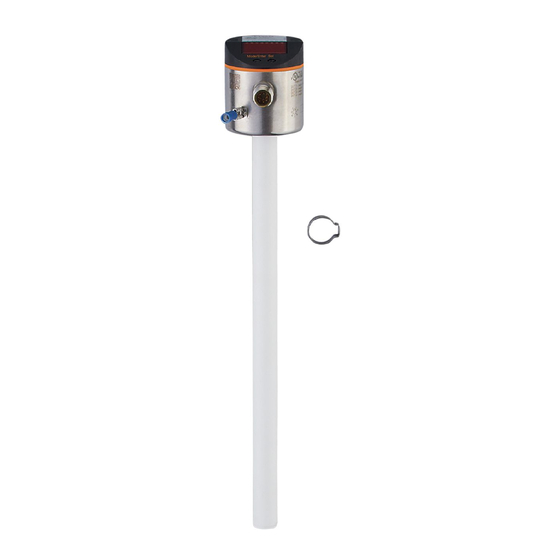
Table of Contents
Advertisement
Advertisement
Table of Contents

Summarization of Contents
1 Preliminary Note
1.1 Symbols Used
Explanation of symbols and their meanings throughout the manual.
3 Functions and Features
3.1 Application Area
Details on suitable applications for the electronic level and temperature sensor.
3.2 Application Area Restrictions
Specifies media and applications where the unit is not recommended.
4 Getting Started
4.1 Example Configuration 1
Step-by-step guide for a specific installation scenario.
4.2 Example Configuration 2
Step-by-step guide for an alternative installation scenario.
5 Function
5.1 Measuring Principles
Explanation of how the device measures fluid levels and temperature.
5.3 Operating Principle and Features
Overview of the unit's operational logic and key features.
5.3.1 Operating Modes
Description of the three available operating modes for the unit.
5.3.2 Integrated Overflow Prevention
Details on the functionality and settings of the integrated overflow prevention.
5 Function (Continued)
5.3.3 Display and Switching Functions
How the unit displays information and manages switching outputs.
5.3.4 Offset and Fault Handling
Setting offset for level and configuring fault response for outputs.
5.3.6 Extreme Value Memory
Retrieving minimum and maximum temperature values.
5.3.7 IO-Link Communication
Information on the IO-Link communication interface.
6 Mounting
6.1 Installation with Overflow Prevention
Specific installation requirements when overflow prevention is active.
6.2 Installation without Overflow Prevention
Installation procedures when overflow prevention is deactivated.
6.2.1 Installation in the Inactive Zone
Mounting the sensor in the inactive zone of the probe.
6.2.2 Installation in the Active Zone
Mounting the sensor in the active zone of the probe.
6.3 Other Installation Notes
Additional important considerations for sensor installation.
6.3.1 Marking Installation Height
Method for marking and securing the correct installation height.
9 Menu
9.1 Menu Structure
Visual representation of the parameter menu hierarchy.
10 Parameter Setting
10.1 General Parameter Setting
Step-by-step process for setting any parameter.
10.2 Basic Settings
Core configurations for the device's fundamental operations.
10.2.1 Output Assignment
Configuring outputs OUT3 and OUT4 for level or temperature.
10.2.2 Display Value Assignment
Selecting the value (level or temperature) shown on the display.
10.2.3 Unit of Measurement Settings
Setting display units for level (cm/inch) and temperature (°C/°F).
10.2.5 Set the Offset
Adjusting the zero point for level measurement.
10.2.6 Set the Medium
Selecting the medium type for optimal sensor performance.
10.2.7 Set Overflow Prevention
Configuring the overflow prevention feature and its position.
10.2.8 Adjust Overflow Prevention
Fine-tuning the overflow prevention setting after installation.
10.3 Setting of Output Signals
Detailed configuration of output functions and switching behavior.
10.3.1 Set Output Function
Choosing the switching logic (hysteresis or window) for outputs.
10.3.2 Define Switching Limits (Hysteresis)
Setting set points and reset points for hysteresis switching.
10.3.3 Switching Limits (Window)
Setting upper and lower limits for window switching.
10.3.4-10.3.6 Delay and Logic Settings
Configuring delays and switching logic for output signals.
10.3.7 Output Response in Case of Fault
Determining how outputs behave during fault conditions.
10.3.8 Configure Display
Setting the display mode and behavior.
10.3.9 Reset to Factory Settings
Restoring the unit to its original factory default parameters.
12 Operation
12.1 Operating Indicators
Explanation of the unit's status indicators and display messages.
12.2 Read Set Parameters
Procedure for viewing configured parameter values.
12.3 Read/Reset Extreme Value Memory
Accessing and clearing stored extreme temperature values.
12.4 Fast Selection Level / Temperature
Quickly switching between displaying level and temperature.
12.5 Error Indications
Troubleshooting guide for common error codes and their causes.
13 Technical Data
13.1 Setting Values [OFS]
Ranges and increments for the offset setting.
13.2 Switching Limits for Level
Ranges and increments for setting level switching points.
13.3 Switching Limits for Temperature
Ranges and increments for setting temperature switching points.
13.4 Setting Values [OP]
Table of values for setting the overflow prevention position.
13.5 Calculation Aids [OP]
Formulas and examples for calculating overflow prevention positions.
13.5.1 Definition "from the cover"
Calculating OP position relative to the tank cover.
13.5.2 Definition "from the bottom"
Calculating OP position relative to the tank bottom.
14 Maintenance / Cleaning / Change of Medium
14.1 Maintenance without Overflow Prevention
Specific maintenance notes when overflow prevention is inactive.
16 Applications
16.1 Storage Tank
Application example for level control in a storage tank.
16.2 Pumping Station
Application example for level and temperature monitoring in a pumping station.















Need help?
Do you have a question about the LT8024 and is the answer not in the manual?
Questions and answers